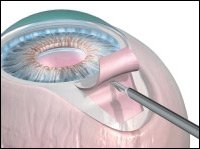TREATMENT OPTIONS
Eye Drops
The glaucoma eye doctors at Anderson & Shapiro Eye Care will us eye drop medications to lower intraocular pressure by either reducing the amount of fluid entering the eye or increasing the amount of fluid exiting the eye. There are several different kinds of glaucoma medications, and each differs in terms of both its ability to lower intraocular pressure and its potential side effects. Laser therapy often is used when medications fail to lower intraocular pressure; it is also used for patients who cannot tolerate medications due to side effects. Recent advances in laser therapy have produced lasers so safe and effective that, for some patients, laser therapy is used instead of medications. If medications and/or laser therapy fail to bring the IOP down to a safe range, surgery is available to lower IOP.
SLT (Selective Laser Trabeculoplasty)
Another way to lower eye pressure is with laser therapy.
A common laser treatment for glaucoma is called selective laser trabeculoplasty, or SLT. Selective Laser Trabeculoplasty (SLT) is becoming a widely accepted glaucoma treatment option. SLT definitely offers a new horizon of hope for glaucoma patients. By using this NEW laser technology, ophthalmologists can now lower pressure, thus possibly avoiding more invasive surgery. SLT might even reduce the dependence on medications or drops. The surgical process typically involves numbing the eye with topical eye drops so that you will not feel the laser treatment. In SLT, laser treatment is applied to the drain of your eye in order to open it up and let fluid exit the eye more efficiently. SLT treatment takes only a few minutes, is performed in the office (not the operating room), is safe, and effectively lowers eye pressure in most people. The treatment is approved by the Food and Drug Administration (FDA) for treating glaucoma and is covered by essentially all insurance plans. After the procedure, anti-inflammatory drops are used.
Laser surgery is still surgery, and can carry some risks. Some people experience a short-term increase in their intraocular pressure soon after surgery.
Trabeculectomy
Trabeculectomy is a surgical procedure performed by an ophthalmologist used to lower eye pressure. By trying to lower the eye pressure damage can be halted from further pressure increases but that damage already done is not reversible. The trabeculectomy procedure involves the surgeon creating a tiny passageway from the inside to the outside of your eye. This helps fluid drain better from the areas it is presently not draining. A trabeculectomy can lower the pressure in your eye and help prevent more damage to the optic nerve.
Shunts
Anderson & Shapiro Eye Care can use a device known as a shunt to lower intraocular pressure. The Ex-PRESS mini shunt is a relatively new device, available in USA since 2002. Over 12,000 implantations have been performed worldwide. During this procedure the glaucoma eye doctor diverts the fluid through an extremely small tube to the outside of the eye. You neither cut sclera, nor the iris. Although the device is as small as a grain of rice, it acts just like a heart stent keeping a pathway open so blood (or fluid) can successfully go around the blockage. The Ex-PRESS provides precise control of the amount of fluid that is allowed to flow out helping the eye maintain a healthy level of internal pressure. The Ex-PRESS mini glaucoma shunt provides effective long term control of intraocular pressure, with a success rate of about 94%. If you have been struggling with high intraocular pressure and would like to seek the medical attention of Madison glaucoma experts our eye physicians are here to help. If you want a second opinion on a diagnosis related to glaucoma treatment option please feel free to call us at 888.708.3937.



